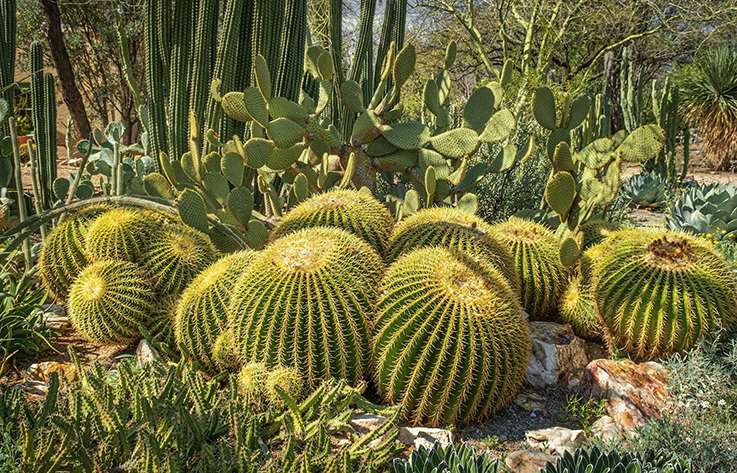The 24 desert plants for landscaping and their characteristics
Sure! Here are 24 desert plants commonly used for landscaping in arid environments, along with their key characteristics:
1. Saguaro Cactus (Carnegiea gigantea):
- Iconic tall and columnar cactus with arms.
- Slow-growing and long-lived.
- Large, white flowers bloom at night, attracting pollinators.
2. Barrel Cactus (Echinocactus grusonii):
- Globe-shaped cactus with ribbed green or blue-green stems.
- Spines arranged in clusters.
- Yellow flowers in spring and summer.
3. Agave (Agave spp.):
- Rosette-forming succulent with fleshy leaves.
- Some species have sharp spines at leaf tips.
- Impressive flower stalks (inflorescence) in mature plants.
4. Yucca (Yucca spp.):
- Evergreen plants with stiff, sword-shaped leaves.
- Tall flower spikes with bell-shaped flowers.
- Tolerant of poor soils and drought.
5. Joshua Tree (Yucca brevifolia):
- Distinctive, treelike yucca native to the southwestern US.
- Clusters of spiky, blue-green leaves.
- Attractive creamy-white flowers in spring.
6. Desert Marigold (Baileya multiradiata):
- Low-growing perennial with bright yellow flowers.
- Blooms in spring and fall.
- Drought-tolerant and low maintenance.
7. Desert Spoon (Dasylirion spp.):
- Grass-like plant with long, spiky leaves.
- Yucca-like flower stalks.
- Adds architectural interest to landscapes.
8. Palo Verde Tree (Parkinsonia spp.):
- Green, deciduous tree with bright yellow flowers.
- Unique green bark for photosynthesis.
- Adaptable to various soil types.
9. Ocotillo (Fouquieria splendens):
- Uniquely shaped shrub with long, spiny stems.
- Bright red flowers bloom after rainfall.
- Provides vertical interest to landscapes.
10. Desert Willow (Chilopsis linearis):
- Small tree or large shrub with willow-like leaves.
- Abundant trumpet-shaped flowers in various colors.
- Attracts hummingbirds and butterflies.
11. Creosote Bush (Larrea tridentata):
- Low-growing shrub with small, resinous leaves.
- Produces a distinctive creosote smell after rain.
- Long-lived and highly drought-resistant.
12. Aloe Vera (Aloe vera):
- Succulent with thick, fleshy leaves containing gel.
- Healing properties for burns and skin irritations.
- Low water requirements and easy to grow.
13. Prickly Pear Cactus (Opuntia spp.):
- Paddle-shaped cactus with vibrant flowers and edible fruit.
- Spines and glochids (small barbed bristles) are present.
- Hardy and adaptable to various climates.
14. Red Bird of Paradise (Caesalpinia pulcherrima):
- Ornamental shrub with fern-like leaves.
- Striking red and orange flowers with yellow stamens.
- Loves full sun and attracts pollinators.
15. Desert Zinnia (Zinnia acerosa):
- Low-growing perennial with small, daisy-like flowers.
- Drought-resistant and thrives in sandy soils.
- Adds pops of color to desert landscapes.
16. Desert Mallow (Sphaeralcea spp.):
- Showy, trumpet-shaped flowers in shades of orange, pink, or red.
- Soft, velvety leaves.
- Attracts bees and butterflies.
17. Golden Barrel Cactus (Echinocactus grusonii):
- Compact, round cactus with golden spines.
- Slow-growing and low maintenance.
- Drought-tolerant and well-suited for containers.
18. Century Plant (Agave americana):
- Large succulent with spiky leaves arranged in a rosette.
- Tall flower spike (up to 30 feet) after several years.
- Low water requirements and deer resistance.
19. Cholla Cactus (Cylindropuntia spp.):
- Segment-like stems with sharp, barbed spines.
- Golden spines reflect light beautifully.
- Excellent for xeriscaping and rock gardens.
20. Blackfoot Daisy (Melampodium leucanthum):
- Low-growing perennial with small white daisy-like flowers.
- Blooms profusely throughout the year.
- Drought-tolerant and attracts pollinators.
21. Desert Agastache (Agastache rupestris):
- Aromatic perennial with spikes of orange or pink flowers.
- Attracts hummingbirds and butterflies.
- Thrives in dry, well-draining soil.
22. Mojave Aster (Xylorhiza tortifolia):
- Low-growing perennial with purple daisy-like flowers.
- Native to arid regions of the southwestern US.
- Resilient and adaptable to harsh conditions.
23. Texas Mountain Laurel (Sophora secundiflora):
- Evergreen tree with fragrant purple-blue flowers.
- Glossy, dark green leaves.
- Tolerant of dry conditions and alkaline soils.
24. Indian Fig (Opuntia ficus-indica):
- Large, flattened pads with edible fruit (prickly pear).
- Showy flowers in various colors.
- Heat and drought tolerant.
When incorporating desert plants into your landscape, consider their water needs, sunlight requirements, and overall growth habits to create a harmonious and sustainable desert oasis. Proper planning and maintenance will ensure a thriving and visually appealing desert garden.
We have also put together interesting content on the types of gardens here.

